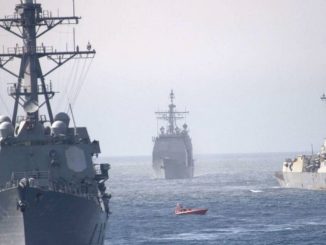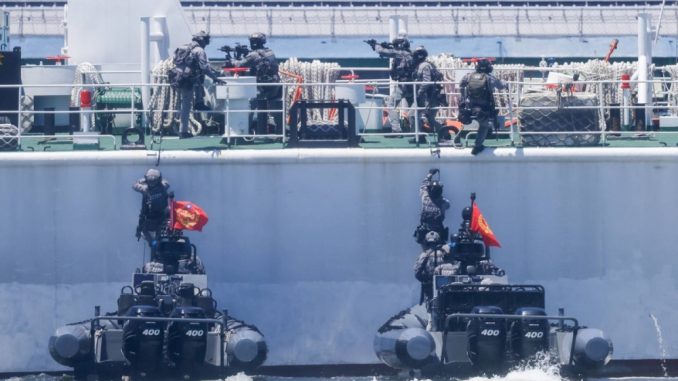
The Taiwanese coast guard conducts its annual drill in southern Taiwan, simulating the seizure of a ferry by ‘international terrorists,’ in collaboration with Taiwan’s military to board and take back control of the boat and evacuate casualties, in Kaohsiung, Taiwan, on Sunday. | REUTERS
| Published June 8, 2025
TAIPEI — Taiwan carried out its first joint drill involving both the coast guard and the military this week, aiming to improve its ability to respond to “grey-zone” activities in the waters surrounding the self-ruled island. The exercise, conducted near the strategically important Port of Taichung, included fast-attack boats, armed coast guard ships, and marine units practicing coordinated maneuvers.
The operation comes amid heightened Chinese maritime activity and reflects what Taiwanese officials describe as a growing need to close the gap between civilian and military responses. During the drill, coast guard ships and navy vessels practiced intercepting unidentified boats, communicating threat assessments, and simulating defensive action in overlapping operational zones.
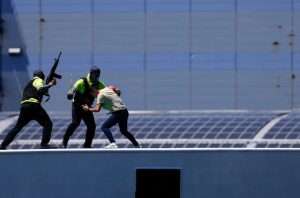
Taiwan’s coast guard conducts its annual drill in southern Taiwan, simulating the seizure of a ferry by ‘international terrorists’, in collaboration with Taiwan’s military to board and take back control of the boat and evacuate casualties, in Kaohsiung, Taiwan, June 8, 2025. REUTERS/Ann Wang Purchase Licensing Rights
According to Taiwan’s coast guard administration, the goal of the drill was to sharpen interoperability between agencies and prepare for non-traditional forms of conflict—often described as “grey-zone” threats. These include sustained presence by Chinese vessels, illegal fishing, and pressure tactics that stop short of open war.
China has ramped up these tactics around Taiwan over the past few years. While not overtly military, such moves are often described by defense analysts as intended to exhaust Taiwan’s response capacity and test its coordination across departments. The coast guard said the drill was planned to mirror the types of ambiguous encounters Taiwanese vessels increasingly face in nearby waters.
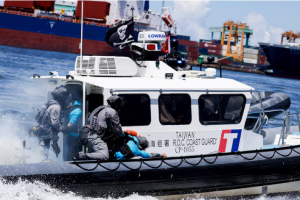
Taiwanese authorities have described the Taichung port as a vital logistics and security hub, making it a logical setting for testing joint operations. Footage from the exercise showed heavily armed personnel securing docks, boarding simulated vessels, and relaying instructions between maritime units.
Officials emphasized that the drill was not a response to any specific incident but part of a regular schedule of preparedness. The Taiwanese government has been pushing for closer integration of civil and military roles in maritime zones as part of its overall strategy to enhance defense readiness.
Security experts such as Bonny Lin, director of the China Power Project at the Center for Strategic and International Studies (CSIS), note that Taiwan’s coastal defenses play a key role in countering broader regional pressure. In interviews, Lin has pointed out that Taiwan’s strategy now includes deterrence through stronger civil-military cohesion as well as investments in asymmetric capabilities and local resilience.
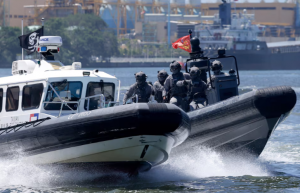
Taiwan’s coast guard conducts its annual drill in southern Taiwan, simulating the seizure of a ferry by ‘international terrorists’, in collaboration with Taiwan’s military to board and take back control of the boat and evacuate casualties, in Kaohsiung, Taiwan, June 8, 2025. REUTERS/Ann Wang Purchase Licensing Rights
The drill included live-communication links between the coast guard and the defense ministry, simulating real-time data sharing and decision-making in the event of a maritime confrontation. While the training event remained open to media coverage, no foreign observers were officially invited.
As Taiwan continues to enhance its defensive posture, exercises like these signal ongoing efforts to standardize joint responses in maritime zones increasingly contested by Chinese activity.
Here’s a timeline of key Taiwan military and coast guard drills focusing on responses to China’s increasing “grey-zone” activities and broader defense readiness:
🇹🇼 Taiwan Military & Coast Guard Drills Timeline
🔹 2023 – Maritime Surveillance Expansion
-
Taiwan expands radar and UAV surveillance along its western coastline in response to frequent PLA Navy patrols.
🔹 April 2024 – Operation Coastal Shield
-
Large-scale naval exercises simulate responses to Chinese fishing militia swarms and civilian ship incursions.
-
Coast guard and navy test inter-agency radio protocols.
🔹 August 2024 – Joint Response Simulation in Penghu Islands
-
Taiwan practices dual-role civilian-military drills involving port shutdowns, coastal artillery deployment, and cyber defense coordination.
🔹 January 2025 – “Grey-Zone Readiness Week”
-
Coast guard conducts surprise boarding drills on vessels simulating unauthorized foreign activity.
-
Ministry of National Defense collaborates with local fishing communities to simulate maritime alerts.
🔹 June 2025 – Taichung Port Joint Drill
-
First-ever combined military-coast guard drill near a major commercial port.
-
Fast-attack boats, marines, and armed coast guard units practice coordinated interception and boarding under ambiguous threat scenarios.
Here are the implications of Taiwan’s recent coast guard–military drills and its evolving strategy against China’s “grey-zone” threats:
1. Taiwan Is Blurring Civil-Military Lines for Maritime Defense
The joint drill signals Taiwan’s shift toward integrating its civilian coast guard with military forces. This blurring of roles may redefine how Taiwan responds to ambiguous threats like illegal fishing, maritime militia, or surveillance ships—treating them as national security issues rather than just law enforcement matters.
2. Grey-Zone Threats Are Now Central to Taiwan’s Defense Planning
Rather than focusing solely on a full-scale invasion, Taiwan is prioritizing hybrid threats that fall below the threshold of war. Drills like the one in Taichung show that Taiwan views routine pressure—like persistent Chinese vessel presence—as part of a broader coercion campaign.
3. A More Proactive, Preemptive Posture
Taiwan’s increasing preparedness, including drills simulating boarding and port defense, may indicate a more proactive defense approach. It prepares Taiwan not just to endure pressure but to respond to it visibly—possibly deterring some lower-level incursions.
4. Heightened Risk of Escalation at Sea
As Taiwan responds more assertively to grey-zone tactics, the potential for miscalculation increases. Military-style coordination in civilian contexts could cause ordinary maritime encounters to escalate more quickly, especially in contested zones.
Overall Takeaway:
Taiwan’s recent joint coast guard and military exercises reflect a strategic adaptation to the evolving nature of Chinese pressure in the region. By enhancing coordination between civilian and military forces, Taiwan aims to strengthen its ability to respond to ambiguous “grey-zone” tactics that fall short of open conflict but pose ongoing security challenges. These drills underscore Taiwan’s recognition that future confrontations may not come as full-scale wars but through persistent, low-intensity actions requiring rapid, integrated responses across agencies.
SOURCES: REUTERS – Taiwan coast guard, military drill to better face China’s ‘grey zone’ threat
THE JAPAN TIMES – Taiwanese coast guard, military drill to better face China’s ‘grey zone’ threat
GZERO MEDIA – Taiwan’s strategy for countering a Chinese invasion, with Bonny Lin of CSIS



